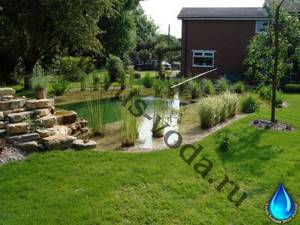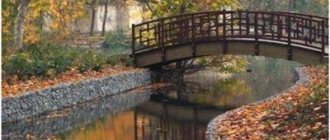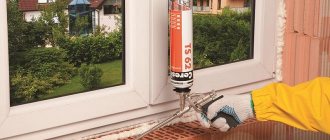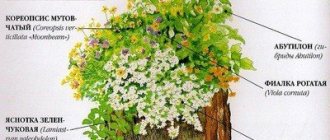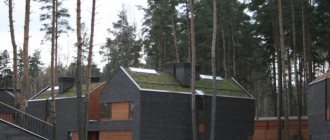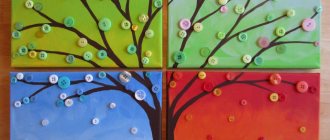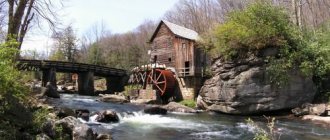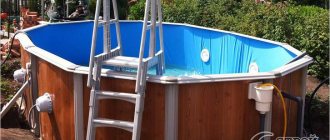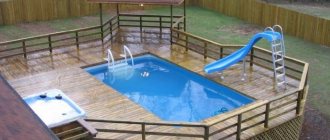Building an artificial pond with your own hands is quite simple. It is much more difficult to maintain, at the proper aesthetic level, the biocenosis of a personal pond. To do this, you must have at least basic knowledge in the field of construction and some branches of biology. The article contains information on how to make an artificial pond and care for it without the use of expensive filters, pumps and other devices based on a closed ecosystem.
Photo. Artificial pond: an example of combination with an alpine slide
Return to content
Types of artificial reservoirs
There are three types of artificial reservoirs, including:
- a dammed reservoir, known since time immemorial, its size can be from several square meters to gigantic ones, with a water area of hundreds or thousands of hectares;
- a reservoir with a soft waterproofing coating of the bed; the sizes of such reservoirs vary, but they are significantly smaller than dammed reservoirs;
- a pond with a solid waterproof bathtub is more often used as swimming pools; they are not made large to decorate the landscape.
Return to content
We independently create an artificial pond and other water sources
The presence of an artificial reservoir in a park composition undoubtedly increases the aesthetic pleasure received by a person, because this landscape element belongs to natural landscaping objects. If such a reservoir has a large area, then it favorably shades the vegetation and has a beneficial effect on the surrounding nature, enriching the landscape.
With the help of such artificial reservoirs you can decorate your suburban area. The microclimate will only benefit from this, because various plants can be planted along the edges of the reservoir, which will allow it to look more natural.
In addition to streams, fountains, waterfalls and cascades, artificial reservoirs also include artificial lakes and ponds.
Imagine how great the stream will look not only on the site, but also on the slopes of the hill. A waterfall will increase the attractiveness of any property, as it can be adapted to any design style. A water source can perfectly complement a rock garden, and in combination with a pond, it can simulate any type of climatic zone. At the stages of construction and decoration of a water source, it is very important to choose the right decorative materials. This includes gravel, rocks and plants as part of the design, which aims to reflect the aesthetics of the land and pond.
The waterfall, as a separate design element, should harmoniously fit into the style of the site and look good on the pond. When water flows from one small water reservoir to another, located at a lower level, a cascade is created. Water cascades make it possible to imitate waterfalls; in addition, you can organize rapids and ledges in them.
To build a fountain, you need to have three components: a water reservoir, a fountain nozzle and a pump. You can decorate the fountain with additional design elements, which are also designed to simplify the management and maintenance of the fountain. Along with decorative fountains, so-called “natural” fountains are often built, in which a stream of water flows directly from pebbles or stones.
You can successfully complement your garden composition with the help of an artificial pond, which is a real highlight of landscape design. Around such a pond, the organisms associated with it will carry out their natural life activities: animals and plants.
Where to start creating a water tank
The construction of an artificial reservoir begins with determining its location. In general, gardening art owes a lot to artificial reservoirs, because with their exceptional beauty they have a beneficial effect on us people. A water source is as necessary for the natural design of a site as plants or terrain.
Landscape art receives additional ways of development thanks to water, which is one of the most attractive elements of the decorative frame of a site. In addition, various water compositions attract attention: it is around them that the design of the garden develops. The main task of the designer in this case is to preserve a holistic picture of the territory.
Having marked the contours of the artificial reservoir, you can begin to construct it. Inside the designated banks, the top layer of soil is cut off, and then they begin to dig a pit of the required depth.
Digging and deepening into the ground continues - and now the outlines of the future water reservoir are visible. If you plan to plant aquatic plants, be sure to dig special holes for them. Check the steepness of the banks: if necessary, make several ledges. After this, level the bottom and walls of the resulting pit. Be sure to remove all rocks, sticks, roots, glass and other sharp objects. After leveling, the ledges and bottom should be covered with wet sand.
After finishing digging, measure the pit and begin purchasing the necessary materials. Butyl rubber and geotextiles must be purchased with a margin of at least 40 cm in order to more than cover the edges of the pit. It is better to choose simple butyl rubber: if stone chips are glued to its surface, over time it will gradually peel off and move to the bottom of an artificial reservoir. This type of butyl rubber is not very durable.
First, a protective fabric is laid on top of the sand, and then a film. At the bottom, the film should be pressed down with a stone, and then laid over the entire plane of the bottom and walls. After uniform distribution over the surface of the water reservoir, those edges of the film that protrude beyond the boundaries of the reservoir should be spread out and also pressed down with stones. It is not recommended to stretch the film too much.
At the next stage, they begin to slowly add water inside the pit. During this process, the film will stretch and gradually adhere more tightly to the bottom and banks of the reservoir. After filling with water to the brim, all excess parts of the fabric must be evenly gathered into folds along the banks. The edges of the folded fabric must be trimmed evenly with a margin of at least 20 cm, and then secured with metal pins. It is advisable to place decorative stones along the edges of the reservoir.
Do not forget that it is most pleasant to relax and spend time near a pond. Therefore, take care to build a gazebo, barbecue, and recreation area nearby.
The attractive, calming and bewitching properties of water are known to everyone. It’s not for nothing that people so enjoy watching the sea waves foaming on the shore and looking at the reflection of the starry sky in the mirror surface of the lake.
An artificial pond embodies the dream of each of us. After all, nothing can compare with raging waves or a quietly murmuring stream, softly ringing drops and smooth, calm surface of water.
Application of geotextile materials
Today, geotextile materials are used not only in construction. Although the most famous of them, road mesh is most often used for reinforcing various structures. These can be sites under construction that must withstand heavy loads, or various drainage systems. Road mesh is also used to strengthen reservoirs and in the arrangement of eco-parking areas. With its help, roads are reinforced, slopes and slopes are strengthened.
To strengthen the slopes, you can use a metal grating. However, it costs more than plastic, and weighs much more. Therefore, it is more preferable to use a plastic grill.
To protect your lawn from trampling, you can use geogrid (also known as geogrid). This plastic grille allows you to avoid the appearance of marks from car treads, and is also used in the arrangement of eco-parking lots. Eco-parking is a part of the green lawn designated specifically for parking. With the help of plastic nets, not only green eco-parking lots are strengthened, but also the bottom and banks of reservoirs, steep slopes and road signs.
Advantages of geogrid
In appearance, the eco-parking looks like an ordinary green lawn sown with grass. When it is covered with a plastic lattice on top, the root system of the grass plantings becomes protected from damage by car tires. Thus, we get parking for vehicles, the appearance of which at the same time makes a favorable impression on people. Eco-parking allows you to place cars on the territory, keeping the lawn intact.
The process of photosynthesis continues in the grass growing in this area, which makes this parking lot the most attractive for placement within the city.
In addition, plastic geogrid protects the lawn from trampling and other damage that can be caused, for example, by mole pests. This material allows you to easily keep eco-parking lots, lawns and ponds in perfect condition. There are plastic grilles on sale for different purposes: they differ in the size of the cells. For example, a lattice with small cells will not allow moles to enter the garden plot. In a specialized store you can purchase geotextile materials for various needs.
Of particular interest is the universal mesh, which can be used both as a fence and as a support for climbing plants or during construction work.
Biocenosis of an artificial reservoir
The biological balance (biocenosis) of a reservoir is maintained by a harmonious combination of several components of the ecosystem. Harmony is especially important for small bodies of water, where it is almost impossible to maintain an attractive appearance without human intervention. Without proper care, a small pond will quickly turn into a swamp, inhabited by frogs or mosquitoes.
Photo. Man-made swamp
The biocenosis of the artificial reservoir is supported by:
- water quality, its chemical composition, the main indicator of water pH;
- the quality of the soil, so in a reservoir with a sandy, stone bottom, or artificial turf, it is easy to achieve water transparency, on the contrary, in a reservoir with a clay bottom or in the absence of drainage, in an artificial reservoir, the water will always be opaque;
- by correct selection of bottom, aquatic and coastal vegetation, selection of aquaculture (fish and crustaceans), balanced reservoirs with periodic addition of water can exist for a long time;
- using filters, aerators or naturally by the three above-mentioned components of the biocenosis.
When choosing what kind of artificial reservoir will be, when building it with our own hands, we will use knowledge about the biocenosis of reservoirs. For example, the pH of the water in a reservoir, as well as the dispersion of soil particles in the water column, is important when choosing fish and aquatic plants. In reservoirs that feed on “soft” water, fish usually experience health problems and it is better not to experiment and abandon aquaculture. Most plants do not grow well in an acidic environment.
Return to content
Choosing the shape of an artificial reservoir
- For a novice builder who has decided to dig an artificial pond with his own hands, we recommend choosing the shape of the reservoir with the correct geometric shapes. The best pit options for beginners have the shape of a rectangle, circle, or oval. The main advantage of such reservoirs is the convenience of excavation work and the simplicity of decorating the space framing the bowl of the reservoir. In addition, structures with the correct outlines fit into the landscape quite easily. A rectangular pond can be supplemented with a waterfall, and a round one can be supplemented with a fountain.

Photo. A square-shaped pond without aquatic vegetation
- We recommend this artificial pond, built with your own hands, of irregular shape, to experienced lovers of artificial ponds who have a sense of style. Such reservoirs imitate the natural coastline quite well. At the same time, it is difficult to choose a form that fits harmoniously into the existing landscape.

Return to content
Choosing the style of an artificial pond
We present the three most popular styles of artificial reservoirs; naturally, there are many more styles.
- Minimalist style implies a pond of regular geometric shapes, perhaps an addition in the form of an artificial waterfall. Such a pond goes well with bright ground vegetation, a lawn around the pond and the absence of vegetation in the pond itself. Water purification – forced filtration.
- A Russian-style pond goes well with an oval-shaped pond or with a coastline that imitates natural forms. The construction of bridges near water is allowed. The vegetation is characteristic of the flora of central Russia. Do not plant bright flowers near a pond. The shrub looks good near a pond. Water purification is natural. In very small reservoirs - forced filtration.
- Exotic (Japanese) style. A body of water in the form of a stream or a curved body of water imitating the bend of a river. The water must be running, with forced circulation, flowing in steps over stones or in the form of a waterfall. To arrange a pond in strict accordance with Feng Shui, contact specialists.

Return to content
Choosing a place on the site for an artificial pond
The choice of location before building an artificial pond with your own hands depends on many factors, including the size of the site and the terrain. Please note the following recommendations for choosing a location for a pond.
- Choose a space sheltered from the winds, on the leeward side of the building (for example, a gazebo). The open side of the reservoir is oriented to the west or southwest. The wind rose for the summer period (the main direction of air flow) should be determined experimentally.
- A source of water is required. To save water consumption, use drainage of rainwater collected from the roof; in this case, think about how to remove excess water into the drainage system and then into the drainage pit. (you can provide a link to a previously written article on sewerage).
- It is good if there is a source of electricity nearby. To maintain the normal functioning of a reservoir, even one with a closed biological cycle, it is necessary to periodically use a pump, light the reservoir, and for other purposes.
- Before digging a pit, determine how long the future reservoir will be exposed to direct sunlight. Optimal insolation of a reservoir, in the hottest month of summer, is no more than 6-7 hours.
- You can get rid of excess sunlight by building or small shrubs planted around a pond, an alpine slide, or a gazebo.
Return to content
Selecting material for an artificial pond
The simplest version of an artificial reservoir, a dam, does not involve the use of a bottom covering with synthetic material. This kind of artificial reservoir is made by an invited excavator with his own hands, in a couple of hours, by pouring a dam from soil, concrete blocks, and other materials. There is only one important condition - you must own a plot of land with a stream or spring and suitable terrain.
All other types of artificial ponds always require a soft, synthetic cover or a hard bath.
Soft cover:
- Polyethylene film (more than 500 microns), cheap material, ideal for beginning pond growers, two to three years, the possibility of using the film, sufficient time to calculate the effort for arranging a more serious reservoir.
- PVC (polyvinyl chloride) film, durable material, resistant to mechanical stress, can crack at sub-zero temperatures.
- Rubber film (butyl rubber) is an elastic material that is resistant to low temperatures, sunlight, has a long service life, is suitable for fish ponds, year-round use, the most promising and frequently used material for creating structures such as an artificial pond with your own hands.
- Geotextile is a permeable material that is used to line the bed of a reservoir as a layer below, sometimes above, the waterproofing layer.
- Decorative films imitating sections of a river bank are made by gluing a water-repellent film with natural small pebbles or other similar materials.
Reservoirs with hard walls:
- Composite material is used mainly for swimming pools, less often for keeping juvenile fish. You can choose the color of the walls from blue to gray. Such material is rarely used as a decorative pond.
- Plastic molds for small ponds, usually kidney-shaped, are a convenient, durable material. The disadvantage is limited volume and difficult transportation in a passenger car; only the smallest bowls can be delivered. Fragile in the cold.
- Reinforced concrete as pond walls is an obsolete material and is currently practically not used. Dismantling such a structure is an expensive undertaking.
Return to content
Making an artificial pond with soft walls
Previously, we agreed to build an artificial reservoir with our own hands, functioning without the use of pumps and filters, requiring a minimum of maintenance. The aesthetic appearance of which is based on the natural interaction of the flora and fauna of the reservoir.
To build a reservoir you will need the following materials:
- Bayonet and shovel shovels;
- Garden wheelbarrow or stretcher;
- Construction cord – 50 meters;
- Pegs 50 cm high;
- Construction hammer;
- PVC tape 20 cm high;
- Rubber hammer for laying stone;
- Construction mortar for soil compaction;
- Nails 100 or 150 mm;
- Polyethylene flexible water hose;
- Geotextiles;
- Film of your choice (polyethylene more than 500 microns, PVC, synthetic rubber);
- Pieces of granite, basalt stones, pebbles, coarse sand, paving slabs;
- Construction level;
- Construction sand;
- Gravel.
Sequence of work:
- We choose the location of the future reservoir. We recommend that novice pond growers dig a pond no more than ten square meters. But do not forget, the larger the water area, the easier it is to maintain the biocenosis of the reservoir. In any case, a margin should be added to the selected area so that about two meters remain from each edge of the bank. Such a platform is necessary for decorating the site with vegetation, other elements of landscape design and the successful natural functioning of the reservoir.
- We outline the contours of the reservoir. We do this with a construction cord laid on the ground according to the shape of the coastline you have planned. Instead of a cord, you can use dry sand.

Photo. Outlining the contours of the reservoir
- We take out the soil. Along the contour, we make a groove, which is necessary for organizing the drainage system.

Photo. Two stages of the future reservoir have been dug
- Leveling the horizon of the coastline. We use a building level (spirit level).
Photo. Leveling the banks to the horizon
- We outline three contours. This is necessary so that the recess is stepped and the reservoir is zoned. We also outline the contours with sand or cord, as described above.
- We take out the soil sequentially to form the future bed of the reservoir. The result was three steps (terraces), including: the first step - for drainage, the second for shallow water, the middle and in the center of the platform with the sinking soil of the reservoir. The optimal height of the terraces is 40-80 cm. The optimal depth of the reservoir in which fish and plants can be kept year-round is 2.4 meters for most regions of Russia. At this depth, freezing of the reservoir is excluded in most regions with the exception of the Arctic. For the Moscow region, when growing water lilies (deep-planted plants) and keeping fish year-round, the permissible depth is approximately 1.2 -1.4 m. Do not forget that the depth of the future reservoir is also determined by the height of the spring groundwater.
- We compact the soil. This is necessary in order to knead large lumps of soil, and simply press the stones. If there are a lot of stones, add sand to the bottom of the bed. This procedure is necessary to prevent film ruptures.
- We do drainage. Along the perimeter of the coastline, retreating 15-20 cm from the edge, we drive pegs to a depth of 30 centimeters with an interval between pegs of 50-60 cm. Pegs located on different banks should be at the same level in relation to the horizon. We put a hose on the butt of the pegs (upper part) and nail it. When finished, the structure looks like a bridge standing on supports. We apply PVC tape to the pegs in the form of a fence. This is done to prevent soil or drainage gravel from falling under the film. As a result, a pocket was formed, with PVC tape on one side, soil on the other, and space between them for laying gravel.
- We lay geotextiles. To prevent ruptures, we lay the material loosely. The upper part, with a good margin, lies on the contour formed by the hose.
- We lay the waterproofing film. We select its dimensions accordingly with a half-meter margin at the edges. A polyethylene film of at least 500 microns is laid in two layers, connected and sealed with a special device. But it’s easier to use rubber film, which can be glued and has a long service life. We also place the film freely in the bed of the future reservoir.

- Fill with water. This is necessary so that the geotextiles and waterproofing film spread along the bottom of the reservoir, following its contours as much as possible.
- We form drainage. It is located along the perimeter of the reservoir. We tuck both insulating materials under the groove. We cut off the excess so that it fills the groove completely. We fill the groove with gravel so that it presses the film as tightly as possible.

Photo. For drainage, instead of soil, it is more advisable to use crushed stone or gravel
Return to content
A little history about artificial reservoirs
Artificial reservoirs became especially popular during the reign of Peter the Great. At that time, personal plots were designed according to Italian and French models.
In the land of the “Rising Sun,” water symbolizes blood, and the stones located along the perimeter of the pond are the skeleton, which is why Japanese gardens are very difficult to imagine without some kind of body of water ( waterfall, fountain, stream , etc.). As a rule, not every garden has natural reservoirs, so the Japanese began to create the necessary sources of water artificially, and subsequently residents of other countries began to use this idea. In Persian and Muslim landscape complexes, fountains, cascades, streams and waterfalls were an integral part, because they created harmony in the garden and also brought peace to the owner.
Decorating a pond
Naturally, at first the pond will look like a dirty puddle with a bunch of construction debris around. The first desire is to decorate the space. Do not hurry. There is no need to run to the nearest swamp for plants and fish. In this way, you can bring a problem that will ruin all your work in a few summer weeks. After all, wild plants are often very aggressive and grow quickly. It’s better to do some real decor.
To decorate artificial reservoirs, stones, gravel, and sand are primarily used. Do not use limestone. It greatly affects the pH of the water. It is ideal to use basalt rocks. Perhaps you will be lucky and will be able to find the necessary material in the nearest ravine. For decorating the shores of an artificial reservoir, decorative films that imitate a sandy or rocky shore are recommended.
On the Internet we found interesting advice on making your own artificial surface based on rubber film and silicone glue for aquariums.
Apply glue to the dry surface of the rubber film and sprinkle it with coarse sand or pebbles on the surface coated with aquarium glue. After some time, after the sealant has hardened, shake off the excess sand. The decorative bank is ready. This coating is safe for fish and plants. The cost of such coverage is much lower than that sold in the store.
The perimeter of the reservoir must be paved with paving slabs or artificial stone to a width of 0.5-1.0 meters. This will prevent soil from getting into the pond.
Place stones in the coastal and middle parts of the reservoir. How to make it depends on taste, remember that any stone should serve its main purpose - maintaining the biological balance of the reservoir, for example:
- for covering eggs, fry and juvenile fish;
- as a barrier to retain silt on steps;
- to fix the plant.
How you decorate a pond with natural materials depends on your taste and capabilities. We recommend watching the video for ideas and recommendations for decor.
Return to content
Why will you like it?
An artificial lake in a country house or local area will not be cheap. However, by contacting us, you can count on us to offer you a number of such options, at least one of which will absolutely triple your needs. Today there are about 5 million lakes in the world. We propose that you create another, albeit artificial, lake at a price that cannot be compared with the pleasure that you and your family will receive from owning it.
A lake in the local area is not only an excellent opportunity to diversify the landscape, make it expressive and surprisingly pleasant, but also an excellent place for the whole family to relax. Depending on the goals set by our customers, the lake can have different sizes; you can swim in it or put fish in it.
In any case, you will get an ideal place for the whole family to relax, which will have a beneficial effect on the microclimate prevailing on the site.
Landscaping the pond
The artificial pond was built with our own hands. The water in it has settled. Typically, biological equilibrium in a reservoir occurs within two weeks. Next, we proceed to populating the reservoir with plants. It is impossible to give universal recommendations to beginners on planting. To successfully plant plants, you will still have to study additional literature and consult with specialists. But in any case, follow these simple rules:
- for planting plants, use plastic containers; soil for plants in reservoirs is just a substrate for fixing the roots, so there is no need to enrich it with organic matter. To fertilize the soil, you can use a lump of clay hidden in the soil.
- do not use a large number of plants. Usually one or two specimens of water lilies in special baskets placed in deep water, a couple of plants in the middle part and several plants in shallow water. This is enough for a start. Ideally, the surface of the reservoir should not be covered with vegetation by more than one third.
- Do not bring into your pond the first plants you come across from the nearest body of water, try to learn as much as possible about the biology of the plant. Avoid the introduction of weeds, which will quickly displace the cultural flora of your pond.
- Ideally, it is better to purchase plants in a special store and get the necessary advice from the seller.
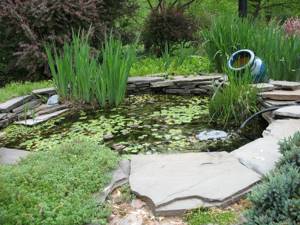
Plants are divided into three groups according to the planting zone in the reservoir:
- Depth up to 10 cm - these are dwarf rush, cotton grass sedge, forget-me-nots growing in shallow water, loosestrife and others;
- Depth 20-40 cm – marigold, arrowheads, buttercups, burrs;
- Depth 60-150 cm - nymphs or water lilies of different varieties and types, cattails, lotuses of different types.
Return to content
What do we offer?
NOBILI specialists have extensive experience in creating artificial reservoirs of various types. If you want to arrange an artificial decorative pond or stream on your property, contact us! We know how to create an artificial lake even in an area where there are no natural springs.
To do this, a pit of the desired size is dug, which is reliably waterproofed and filled with water. The lake will be replenished with water as it evaporates. Depending on the customer’s wishes, we will create amazing areas for relaxation, swimming, as well as terraces and shallow waters where plants can be planted.
Of course, in words, creating an artificial lake sounds very simple... In fact, the process involves a number of difficult works and complex calculations, in which it is necessary to take into account the features of the object, the style of design of the surrounding area, the size of the future lake and a number of other important aspects.
Artificial pond with waterfall
The picture below shows a drawing of a do-it-yourself artificial reservoir with a waterfall. The process of building such a reservoir is practically no different from the scheme described above, except that communications and a foundation for the pumping system should be provided in advance, and also think about supplying power to it.

Return to content
Construction of ponds and bathing reservoirs
|
| Area: 100 - 5000 m2 Construction: 0.5 - 2 months Price: from 900,000 rub. |
Application : swimming ponds on private property. Features of artificial reservoirs with a total area from 100 to 5000 m2:
- Water purification occurs through the installation of disinfecting equipment, biofilters and the creation of bioplateau zones;
- Knowledge of incoming water quality and soil geology can save costs on filtration equipment and waterproofing.
We provide: Turnkey construction of a pond - sketch, design, construction of a reservoir, commissioning of the facility. What the project includes: solving problems of waterproofing the pond, planning slopes and bottom, bank protection, options for decorating the bottom and coastline, water supply and purification schemes, instructions for further maintenance. The price for the construction of an artificial swimming pond will be from 900,000 rubles. Depends on the area of the reservoir, decoration materials, cleaning systems and waterproofing method.
Stocking the reservoir with fish
Fish in an artificial reservoir are not an obligatory element of the biocenosis. It is better to stock reservoirs with a depth of at least one and a half meters, the optimal depth is more than two meters. Otherwise, you will have to catch fish every year in the fall and spring. In winter, keep in a non-freezing reservoir. For beginners, we recommend trying to populate a pond with decorative Koi carp. These fish, Japanese selection, beautiful colors. In a transparent body of water they attract attention. Feeding and maintenance recommendations can be obtained when purchasing fish at a pet store.

Photo. Artificially bred pond fish
Among the more accessible fish suitable for pond keeping, we can recommend pond carp and silver carp - these are inhabitants of reservoirs, either herbivores or feed on small crustaceans. A separate group is predatory fish, such as perch and pike. Follow the rule. Do not keep herbivorous and predatory fish together.
We hope in this article you have received an initial idea of how to build an artificial reservoir with your own hands and how to carry out initial measures to populate the reservoir with plants and fish. A reservoir built with your own hands is an excellent solution for lovers of flora and fauna to gain experience and enjoy contemplating the beautiful views of a miniature reservoir. Remember - landscape designers will build a pond and leave, but it’s still up to you to take care of the pond.
Return to content
Artificial reservoirs, what they are and what are their advantages
artificial ponds on their plot , not so much because of the attractive appearance, but to maintain a favorable microclimate on their land.
There are several types of artificial ponds , which are especially popular among owners who want not only to bring a piece of nature into their garden and make it more attractive, but also to turn the disadvantages of the garden into its advantages:
- Streams, springs and ponds. These bodies of water visually enlarge the area, adding volume and uniqueness. The mischievous murmur of water can lift your mood and improve your well-being. Thanks to the winding banks of the stream and skillfully selected stones located around, a variety of plants, the garden and everything around it comes to life. ponds that are mesmerizing in their picturesqueness , as a rule, bridges of different shapes and designs are installed, islands of various shapes are arranged, on which all kinds of plants are spread out like a bright green blanket.
- Fountains, waterfalls, cascades . These artificial reservoirs have a special appeal, because with their help you can add charm to the overall landscape, because what could be more beautiful than looking at transparent drops of water that fall from the top of a waterfall in a joyful rush? The fountain not only brings the living energy of nature into the garden, but also reflects the tastes and preferences of its owner. Plants decorating artificial ponds add completeness to the overall picture and also fill the surrounding space with clean and fresh air.
- Swamp . Thanks to the swamp, you can create an atmosphere of calm and orderliness in the garden. Even on a small plot of land, this artificial pond will fit perfectly, emphasize its beauty, and complete the holistic appearance of the plot. Various types of climbing plants and all kinds of flowers along the banks of the swamp make being in the garden comfortable and cozy, allowing you to relax and take your mind off bad thoughts.
